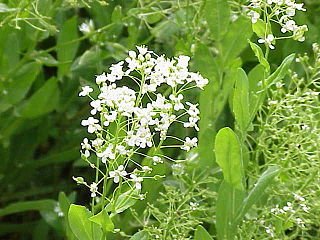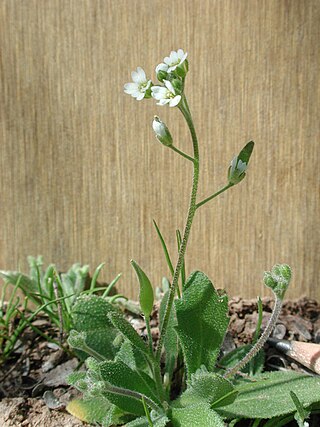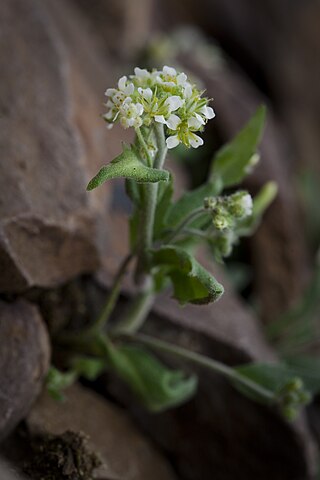There are over 190 vascular plant species on the Norwegian Arctic archipelago of Svalbard. This figure does not include algae, mosses, and lichens, which are non-vascular plants. For an island so far north, this number of species constitutes an astonishing variety of plant life. Because of the harsh climate and the short growing season, all the plants are slow growing. They seldom grow higher than 10 cm (4 in)

Draba is a large genus of flowering plants in the family Brassicaceae, commonly known as whitlow-grasses.

Draba aizoides is a species of flowering plant in the family Brassicaceae, known as yellow whitlow-grass. It is native to Europe where it is found on limestone rocks and walls. In the British Isles it is found only on the Gower Peninsula in Wales.

Lepidium draba, also known as whitetop, hoary cress, or Thanet cress, is a rhizomatous perennial flowering plant in the family Brassicaceae. It is native to western Asia and southeastern Europe and has been widely introduced elsewhere.

The putative hybrid cultivar Ulmus × hollandica 'Serpentina' is an elm of unknown provenance and doubtful status. Henry identified it as intermediate between U. glabra and U. minor, a view accepted by Bean and by Melville, who believed that the specimens at Kew bearing the name 'Serpentina' were U. glabra "introgressed by U. carpinifolia" [: U. minor] and were similar to but "distinct from 'Camperdownii'".

Draba verna, common whitlowgrass, is a species of plant in the cabbage family. It is a small spring-flowering annual which is widely dispersed around the world, and which is found on walls, pavements and patches of bare ground. It has a complex taxonomy which is not yet fully elucidated.

Draba albertina is a species of flowering plant in the mustard family known as the Arc dome draba,slender draba or slender whitlow-grass.
Draba californica is a species of flowering plant in the family Brassicaceae, known as the California draba.

Draba cuneifolia is a species of flowering plant in the family Brassicaceae known as the wedgeleaf draba or wedgeleaf whitlow-grass. This annual plant is native to the southern half of North America where it grows in open, rocky fields and other disturbed areas. The plant forms a basal cluster of leaves, which are thick, widely toothed, and coated in stiff hairs. It bolts one or more erect stems which may approach 40 centimeters in maximum height. Each hairy stem bears an inflorescence of up to 75 small white flowers that continue at intervals down the stem as the stem grows in height. This family and its plants are easy to identify with its 4 petals and 4 sepals arranged like a "cross", either in an "X" or "H" shape, thus the name "Cruciferae". Mustards have 6 stamens usually 4 are taller and 2 are shorter. Fruits are either a long thin silique or short often rounded silicle.
Draba subumbellata is a species of flowering plant in the family Brassicaceae known by several common names, including parasol draba, mound draba, and White Mountains cushion draba. This small perennial plant is native to the White Mountains which straddle the California-Nevada state line and the Inyo Mountains nearby. It lives on barren rocky scree above 3000 meters.

Draba breweri is a species of flowering plant in the family Brassicaceae known by the common names cushion draba, lanceleaf draba, Brewer's draba, and Brewer's whitlow grass. With Draba cana now considered a variety of this species, it is distributed throughout parts of northern and western North America, including much of Canada and the western United States. The less widespread var. breweri is limited to mountainous California and western Nevada.
Draba corrugata is a species of flowering plant in the family Brassicaceae known by the common name Southern California draba.

Draba monoensis is an uncommon species of flowering plant in the mustard family known by the common names White Mountains draba and Mono draba.

Draba pterosperma is an uncommon species of flowering plant in the family Brassicaceae known by the common name wingedseed draba. It is endemic to Siskiyou County, California, where it is known only from the Marble and Salmon Mountains of the Klamath Range. It is a small perennial herb forming dense mats or cushions of hairy, oval-shaped leaves each no more than a centimeter long. The erect inflorescence bears several white flowers that yield flat oval-shaped siliques containing winged seeds.
Cymopterus goodrichii is a rare species of flowering plant in the carrot family known by the common name Toiyabe springparsley. It is endemic to Nevada in the United States, where it occurs in the Toiyabe and West Humboldt Ranges.

Draba ramulosa is a rare species of flowering plant in the family Brassicaceae known by the common names Mt. Belknap draba and Tushar Mountain draba. It is endemic to Utah, where it is known only from Mt. Belknap in the Tushar Mountains in Beaver and Piute Counties.
Draba burkei is a species of flowering plant in the family Brassicaceae known by the common names snowbasin draba and Burke's draba. It is endemic to Utah in the United States, where it is known from Box Elder, Cache, Morgan, and Weber Counties. This plant was considered a variety of Draba maguirei until 2004, when it was elevated to species status.
Physaria fremontii is a species of flowering plant in the family Brassicaceae known by the common name Fremont's bladderpod. It is endemic to Wyoming in the United States, where it occurs only in and around the Wind River Range in Fremont County.

Draba ramosissima, the branched draba, is a species of flowering plant in the family Brassicaceae. It has a restricted range, being found only on calcareous cliffs of the Appalachian Mountains, the Kentucky River Palisades, and Middle Tennessee. It is a small perennial herb with racemes of white flowers in the spring.

Draba nemorosa is a species of flowering plant belonging to the family Brassicaceae.













